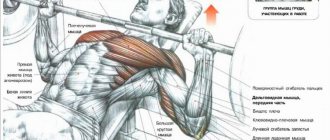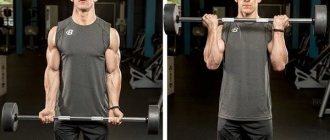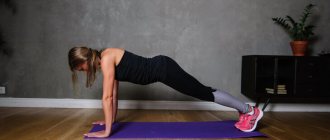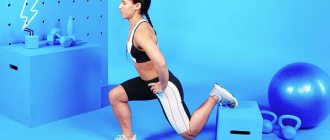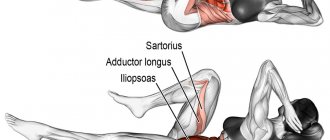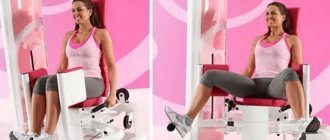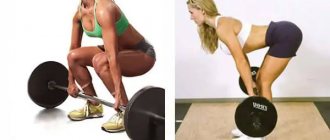Abdominal exercises are done at the end of each workout. But not all, and not always. In bodybuilding, incline crunches are a necessary part of the plan for the beginner and intermediate athlete. Those who have fairly hypertrophied abs usually only “pump up” them with simpler exercises. In other strength disciplines, incline crunches are also used. Strength workers do it to compensate for the deflection in the spine that occurs when squats. Athletes of other disciplines - just to pump up their abs. This popular movement has quite a few subtleties. After all, most athletes do it incorrectly, but solely through the quadriceps and body jerks. But once you learn how to do the twist correctly, you will feel the difference.
Execution technique
Initial position
- Secure your knees to the bolsters of a crunch bench;
- Press your buttocks against the surface of the bench;
- Tighten your stomach;
- Place your hands behind your head;
- Lean back to horizontal
Movement
- As you exhale, contract your abdominal muscles;
- Bring the lower ribs to the pelvic bones;
- Pull your stomach in even more;
- At the peak of the contraction, pause for a moment and then repeat.
Attention
- Technically, some people do a full lift rather than a crunch. They lie down on a bench and, due to the inertia and strength of the quadriceps, lift the body completely. It is not advisable to perform this movement exactly this way, because the press will no longer work in such a technique;
- There is no need to bend your lower back inward to increase the amplitude. This overloads the back and can lead to protrusions;
- Pressing your palms on the back of your head should be avoided. If the pressure is too strong, the cervical vertebrae may be displaced;
- The bench should be adjusted so that the shins do not move too far away from the pads of the machine when lowering the body down.
Recommendations
- The twist is performed by rounding the back rather than by “bringing” the shoulders toward the knees with a strong flexion at the hip joint. Round your spine and roll your shoulders forward;
- Try to follow the principle of “exhale with effort.” The peak contraction at the top point should be performed when there is almost no air in the lungs;
- Work smoothly, avoid jerking, so that the efforts to lift the body become more measured, and the insulation works
It's a PRECIOUS TRUSH, baby.
Execution options
- In a Roman chair . This machine is designed to protect the athlete's back. It is only important that it suits the athlete’s height. It is necessary to ensure that the pelvis does not come off during twisting. The athlete can perform a backbend slightly deeper than a normal crunch;
- Diagonal or cross crunches . In this version of the exercise, we reach with the opposite shoulder towards the hip or knee. This option should work the oblique muscles more. But it does not provide significant hypertrophy, so those who want to have a thin waist can also do it;
- Twisting from a lying position on a bench . This variation is reminiscent of the classic crunch while lying on the floor. A full body lift is not required here. The athlete's goal is to bring the lower ribs to the pelvic bones. You need to pull in your stomach, and gradually bring your ribs to the pelvis, and then lower yourself to the starting position;
- Weighted crunches . They help not only to build muscles, but also to work out the abs in strength mode. The abs are also pumped with weights in order to get “pronounced abs” and muscle hypertrophy.
How and how much to raise your legs
To get the maximum effect from your training, you need to adhere to the correct technique.
Technique
When training your abs on an incline bench, follow this technique:
- Lie on your back, bend your knees so that your heels are supported. Bend your elbows and grab the holder at the end of the bench.
- Stretch your back under your own weight and tighten your back muscles. When bending and extending your legs, your back should remain motionless.
- Tighten your abs and cross your ankles. This position is the starting position; in it you can relax a little and breathe more calmly (but it is still better to “keep” the corset muscles tense).
- After a short inhalation, while holding your breath, try to stretch your knees to your chest (namely, to your chest, not to your head). The lower back cannot be torn off, while the symphysis pubis should stretch towards the chest.
- When your thigh is perpendicular to the bench, you can exhale and slowly lower your legs.
- The legs cannot be completely lowered; they must always remain suspended. This allows you to constantly keep the muscle complex in tension. After you lower your legs, inhale and lift again.
Correcting a curved spine with the help of strength exercises, including lifting the legs on an inclined bench, is possible only in childhood and adolescence. If you have problems with the spine and are over 20 years old, it is better to consult a doctor before starting training to avoid complications.
When twisting your pelvis at the end of the movement, try not to lift your lower back off the bench, otherwise the entire effect of contracting the lower segment will be lost. And instead, the rested middle segment will be included in the work.
You can get acquainted with the correct technique for performing the exercise using the video:
Number of repetitions
Beginners are advised to start with three sets of 10-15 repetitions . In the future, you can complicate the training processes by slowing down the pace and increasing the delay time in the upper position. You can also use additional weight on your legs and increase the number of repetitions. A good effect will be if the lowering and raising processes are performed as one smooth continuous movement.
Anatomy of exercise - which muscles work
Target working muscle and auxiliary muscles:
- Rectus abdominis muscle
- Quadriceps, obliques, tensor fasciae lata, iliopsoas
Benefits of the exercise:
- Suitable for beginners;
- Allows you to progress and increase the load;
- Not dangerous;
- Has many modifications and options
Flaws
Those who go to an inexpensive gym will have to suffer for quite a long time if their shins are slightly larger than those of the average person. It is not convenient to train on an incline bench for those who have large hamstrings. Such people cannot always adjust a cheap small shop to suit themselves. More professional equipment takes into account the anthropometric characteristics of professional athletes. The second disadvantage is the inability to adequately perform the movement at home. They sell universal benches for the home, but they are only convenient for working out your abs, and not for performing other exercises as well.
About two implementation options
Among ordinary gym goers, debates sometimes flare up about how to do leg raises correctly.
There are supporters of performing only leg lifts, while others argue that the exercise should be done with the obligatory lifting of the pelvis upward at the final point.
In this situation, both options will be correct.
The first, with the back pressed, minimizes the participation of the lumbar muscles in the movement, which minimizes the load on this part of the spine.
This form of exercise is suitable even for people with back pain.
The second option is more complex both in technical execution and in terms of physical fitness.
Raising the legs followed by lifting the pelvis has a greater impact on the abdominal muscles. But at the same time, it increases the load on both the lumbar muscles and the spine itself.
This technique will only be useful for people with a healthy back.
Preparation for execution
You need to set the inclination of the bench to about 30 degrees, and adjust the height of the locking rollers so that your legs are comfortable and your pelvis remains on the bench when lifting. It is necessary to practice lifting onto the bench and develop the starting position.
If the projectile swings from side to side, it is worth strengthening it by placing pancakes on both sides of the legs.
The abs are usually worked out at the end of a workout, and there is no need to warm up before them. If a person has problems with mobility in the hip joints, he should perform circular rotations of the pelvis, abduction of the hips to the side, and bends forward in a volume sufficient to warm up.
Abdominal exercises. Lifting the body.
Row of two dumbbells to the belt
The exercise resembles a standing bent-over barbell row. If the athlete already knows how to perform this deadlift, his task becomes easier. It is enough to select the weight of the dumbbells. The exercise allows you to work your back and does not overload your leg muscles. It is technically simpler than the bench-supported row option, as it requires almost no stretching.
When taking the starting position, it is important to grip so that the dumbbells do not hang on the athlete’s fingers. The grip should be the same on both sides
The athlete performs a slight forward bend, the universal starting point is a back tilt of 45 degrees. Then you need to bend your knees slightly so that you can stand comfortably and the load does not go into the hamstrings.
Next, the exercise is performed by bringing the shoulder blades together, that is, the start occurs by bringing the shoulder blade to the spine, then bringing the dumbbells to the belt. The elbows move in a plane parallel to the spine. It is not recommended to move the forearms perpendicular to the spinal column. The exercise is performed smoothly; the movement should not be jerky or jerky. The biceps are flexed just enough to bring the dumbbell to waist level.
This exercise can be performed in the “balance” version, that is, pulling one dumbbell at an angle towards the waist. This is a rarer option, it is used in strength sports to balance the work of the halves of the athlete’s back. This option is quite rare in bodybuilding, but it makes sense if an athlete has difficulty performing bent-over rows with a barbell and tends to extend too sharply as the barbell moves towards the waist.
Bent-over dumbbell row: technique
We recommend reading: How to lose weight if you work a lot, take care of your family and live in the real world? Vasily's story
Dumbbell rows while lying on a bench
In this version, the backrest is installed so that the athlete can bring the dumbbells to the belt by tensing the latissimus dorsi muscles. The task becomes more difficult, since the legs only rest on the floor, and it will not be possible to pull the weight by slightly extending the back. Many people consider this row to be similar to the T-bar row, but this is not entirely true. The weight is distributed absolutely evenly, and therefore it turns out to develop the muscles harmoniously.
To perform this option, it is enough to tilt 30 degrees, lie on the bench with your stomach, grabbing dumbbells, and bring them to your waist, while simultaneously pulling your shoulder blades towards your spine and contracting your back muscles. The biceps should not pull the weight alone; the start occurs by bringing the shoulder blades together and contracting the lats. In this exercise, the rhomboid muscle also works, but the trapezius muscle is turned off due to emphasis and stabilization.
Errors
Insufficient body tilt. If the inclination is too high, you can transfer part of the load to the trapezius muscles. This will lead to the back not being worked enough. The same thing happens when an athlete actively “pulls” his body, performing small amplitude lifts;
Too much weight. If an athlete cannot retract their shoulder blades with any variation of the bent-over row, the weight is too heavy. In this case, the weight is “accelerated” by the biceps, which can lead to ligament injury;
Performing the exercise in jerks. Snatches throughout the entire amplitude are not only a traumatic activity, but also a technique in which the load goes into the body. When jerking, impact injuries are possible, as well as increased stress on the spine;
Raising your elbows to the sides. Some athletes perform swings instead of flyes, this leads to a transfer of load to the rear deltoid
Proper execution
- The twisting of the spine itself begins at approximately two-thirds of the amplitude, at the top. Lifting is carried out due to the strength of the abdominal muscles, and not due to inertia, “acceleration” of the body with the legs, or contraction of the quadriceps;
- You should not put pressure on the back of your head with your hands. They should either lightly hold the head at the temples, or be extended along the body. It is not recommended to stretch your arms forward, as this contributes to the development of the wrong habit - stretching your chest and neck forward, rather than curling towards your hips;
- The lower back should be kept as flat as possible, not rounded too much;
- There is no need to throw your head back or pull your chin forward;
- You can round your shoulders forward; you don’t need to rise with a straight back;
- At the top of the amplitude, the spine makes approximately a right angle with the femur
Oblique crunches on a bench
Crunches are aimed at increasing the contraction of the external oblique abdominal muscles, but this does not mean that the rectus abdominis muscle works less.
- Place your feet under the support cushions.
- Place your hands behind your head and round your back.
- As you inhale, lean back, without straightening your lower back, to approximately a right angle between your hips and torso.
- As you exhale, begin to twist and from the middle of the amplitude, turn your body diagonally, aiming your right elbow towards your left knee, but do not straighten your spine, constantly keep your back rounded .
- As you inhale, in reverse order, slowly lean back to the bottom point of the movement with your torso level.
- Exhale and twist diagonally in the opposite direction.
- And while inhaling, return back to the lowest point. Perform the same number of repetitions on both sides.
Recommendations for effective implementation
- You can increase the load by increasing the angle of the back of the bench. Beginners can start the exercise from an almost flat bench, gradually increasing the angle;
- Additional weights for this exercise are a barbell or medicine ball;
- Static retention at the top point is allowed;
- The super-slow method also increases the load, that is, twisting for 10 counts and the same slow lowering;
- The closer the hands are to the head, the more actively the press turns on. But if you grab your hips with your hands, nothing will work
Benefit of the exercise
- Does not load the grip, can be done on the same day with rows and deadlifts;
- Allows progression of the load - the angle of the bench is adjustable, the greater the inclination, the higher the load;
- Gentle work for the shoulder and elbow joints, as well as the lower back;
- Those who wish will purchase a bench for home and will not miss training;
- An option with weights on the shins is allowed for advanced;
- The exercise does not put stress on the cervical spine and allows you to achieve good shape without back pain;
- It is a general physical fitness movement for sports such as running, cycling and swimming;
- Does not cause waist expansion
Inclusion in the program
The training program is an individual thing. Many people combine several abdominal exercises in one workout, such as hanging leg raises or lying leg raises. Others believe that there is no particular point in doing 2-3 abdominal exercises. In fact, straight crunches tone the abdominal muscles, and can help with abs if a person has a little body fat. But those who have problems with posture and pronounced lordosis should also do leg lifts.
If a person does a lot of barbell crunches and hyperextensions, it makes sense for him to do leg raises rather than crunches. This will help avoid hypertonicity of the iliac muscle and pain.
In strength disciplines, straight crunches on a bench can be combined with standing crunches, that is, an exercise similar to “prayer”, but performed while standing. Strength athletes should remember that 3-4 approaches with a weight that can be used to perform a twist 5-6 times is quite enough. Six packs, burning sensations and other stories about “beautiful abs” should be left to fitness models. To squat and bench a lot, you need strong abs, not a thin waist.
For those who want to lose weight, doing too many abdominal exercises is also not recommended. 2-3 working approaches to failure at the end of the workout is the required minimum, and it is also the maximum. If you overtrain your abs, they will not become sculpted and beautiful faster. Some bodybuilders do 3-4 working sets of 20 reps, but this is beyond beginner level.
Promo (hall): Crunches while sitting on an incline bench
Description and benefits of the exercise
When lifting your legs on an incline bench, you can support yourself with your arms, which allows you to better control your back. In addition, this training does not require proper breathing control skills, which is very convenient for beginners .
This type of training spares the pelvic organs as much as possible. It belongs to a set of physical therapy for gastrointestinal diseases and gastritis. When performing this type of exercise, your legs are constantly being stressed, as gravity will always act on them.
If 12% of your body weight is subcutaneous fat, then your abs should be perfectly visible.
To perform this type of training, you need to lie down on a bench and grab its upper part with your hands (this can be a crossbar or special stops). The lower back should be pressed tightly against the bench, and the legs should be raised and slightly bent at the knees (the hips should be at right angles to the bench).
You need to raise and lower them very smoothly, while trying to fix your knees and not bend them. Breathing should be even, there is no need to strain too much. You need to exhale at the top point of the lift, and inhale at the bottom. When raising your legs, they should be as close to your chest as possible.
The effect of this exercise is more optimal for obese people. Exercise on an abdominal bench allows you to work more closely with your weight. In addition, such training allows you to involve the shoulder girdle in the work and have a positive effect on spinal traction.
Overweight people whose belly hangs down from the sides use a bandage. In any case, this training method allows you to bring the body to a normal physical state.
Contraindications
This exercise is not recommended for any injuries of the hip joints and femoral neck. Back and lower back problems should also be addressed before the client discovers the incline bench. Even simple discomfort in the lower back means that it is better to switch to a fitball, or lying down;
Hypertensive patients should not make the bench angle too high. A significant angle of inclination promotes a rush of blood to the head and can lead to pressure changes;
A bench with a high rise is not recommended for those who have myopia and a tendency to retinal detachment. Such a person should not actively perform exercises in which the head is lower than the chest. Moreover, you should not “strain” when pumping up your abs. It is better to do hanging leg raises with this condition;
The exercise can also be quite unsafe for spinal hernias. If there is no deterioration, the choice of exercises should be discussed with your doctor.
Recommendations for increasing efficiency
When performing leg raises on an incline bench, the level of load on the abdominal muscles varies widely.
There are several ways:
- Leg movement amplitude
As mentioned above, the legs are raised either to a right angle with the body, or with the pelvis lifted off the bench. The second option is more difficult.
In addition, the movement is performed with straight or bent knees. Which also regulates the load up and down, respectively.
- Bench angle
Not every equipment has this capability, but still.
The more the back of the bench is raised, the harder it is to perform leg raises. And vice versa, the smaller the angle of inclination, the easier it is.
- Using additional weights
If necessary, the exercise is complicated with the help of weights that are placed on the ankles.
- Changing training load parameters
These include increasing the number of sets and repetitions, reducing the rest between sets, or slowing down the pace of movement.
All this complicates the exercise, thereby increasing its effectiveness.
But remember, before moving on to complex methods, learn to control the basic version of the movement perfectly.
Tips and Tricks
- Change the angle of the bench. If the exercise is easy, the angle can be increased. The larger the angle, the higher the load.
- If you don't feel the strain at a high angle, hold a dumbbell between your feet. Choose a weight so that the exercise is difficult, but possible with the right technique.
- One weight option is to keep your feet on the bench and start the next repetition a few centimeters away from it.
- If you want relief, do the exercise with weights and limit the number of repetitions to 10-12.
- To get straight legs, you need to stretch before and after your workout!
- If you need endurance, do it without weight and as many times as you can.
- After the exercise, lie on your stomach and arch back, standing on your hands. Be sure to stretch your abdominal muscles after the exercise!
Attention: before using weights, do 10-15 repetitions without weight to warm up!
How to do the body lifting exercise correctly: important features
Execution technique
The correct technique for performing sit-ups in a prone position is as follows:
- Starting position - the athlete lies on his back: the lower back is pressed to the floor, the heels also touch the floor and do not leave it throughout the entire exercise. Toes can be raised.
- The hands are placed behind the head, the fingers are clasped.
- We directly lift the body: while exhaling, we rise with a straight back. It would be a mistake if your knees exceed a 90-degree angle and your buttocks lift off the floor. In this exercise, it is the abs that should work as much as possible, due to the contraction of the rectus abdominis muscle.
- After this, we lower the body until your shoulder blades touch the floor. We do not stay in the starting position for long and perform the lift again as many times as necessary. As a rule, do 3-4 approaches.
A photo of body lifts from a supine position is shown below.
What are the errors?
The worst mistakes are considered if you:
- bent your back;
- did not reach the vertical line with the body;
- your hands are not held behind your head;
- lift your buttocks off the floor.
How can you make the exercise more difficult?
To notice a specific result, you need to train your abdominal muscles 3 times a week for 4 approaches for 6 weeks. As you practice, you can make this exercise more difficult.
We have already described the simplest option, but more complex ones are lifting the body with raised legs to an angle of 45-60 degrees. You can also put your feet on a sofa, bed, stool and do lifts in the same way. This position reduces the load on the lower back.
Below is a video with an example of the correct execution of body lifts.
Important! When you hold your hands behind your head, do not pull yourself with your hands. They are simply located behind the head, elbows pointing to the sides
Rise up using your abdominal muscles only.
What do we do after completing the exercise?
After a good workout, you need to stretch. The muscles are warmed up, so it's good to stretch.
There are also stretching exercises for the abs: lifting the body from a lying position on your stomach. With its help, the back extensor muscles are well trained.
How to do this exercise? First you need to lie on your stomach. The face looks at the floor, the arms are located along the body, the legs are spread shoulder-width apart. As you exhale, we lift the shoulder girdle, hold for a few seconds and gradually lower. To increase the difficulty, you need to simultaneously raise your arms and legs with your body, as high as you can do it. All movements must be smooth and controlled.
For such training, no additional equipment is needed; you can do these exercises anywhere: on vacation, at home or outside in the warm season. Even if you do not have the opportunity to attend a training session at a fitness club, this is not a reason to skip classes. You can train in any conditions for the benefit of your health and your figure, adhering to the correct technique.
We really believe that our advice and workouts, which are on our website, will help you transform and achieve the body of your dreams. Incorporate the sit-up exercise into your workout routine and your abs will definitely become flatter.
I wish you success!
Various performance techniques
Let's look at three options for lying leg raises, designed for people with different levels of physical fitness:
- People with weak abdominals who want to strengthen them.
- Physically trained people who want to make their abs stronger and more prominent.
- Athletes who require increased exercise.
For each category we present one version of the exercise.
Alternating Leg Raises for Beginners
Also, this version of the exercise is indicated for osteochondrosis or recovery after abdominal surgery.
- Starting position – lying on your back, lower back pressed to the floor. The arms are extended along the body or clasped behind the head.
- Beginners can raise their heads. Feet together. Raise one leg to an angle of 45–60 degrees, hold it for 1–2 seconds and lower it to the starting position.
- When the heel of the first leg touches the floor, you can lift the second leg.
- Repeat the same for the second leg.
For beginners, it is recommended to do this exercise every day, 1-2 sets of 10 times for each leg.
Watch your breathing. Exhale at maximum load. That is, we raise our legs - exhale, lower them - inhale.
During pregnancy, it is better to cancel this exercise. Women should put less stress on their abs than men. Overdeveloped muscles can make childbirth difficult.
Simultaneous leg lift without weights
This exercise option is suitable for healthy people with an average level of physical fitness.
- Starting position: as in the previous case. That is, lying on your back, on the floor. Raising your head is not recommended, as this makes the exercise easier. Feet together.
- We begin raising both legs to an angle of 45–60 degrees, pause for 1–2 seconds while raised and lower them back.
There are two variations of this exercise technique:
- Lowering your heels to the floor. This is easier to do, because when you touch the floor, your abs rest.
- Without lowering your heels onto a horizontal surface, leaving 1-2 cm to it. This is the most effective version of the exercise, which keeps your abs tense all the time.
It is recommended to perform 2-3 sets, starting with 10-12 repetitions. For yourself, you can reach 30 repetitions in each approach. You should start with the first option, when your feet fall to the floor. After 1–2 weeks, you can move on to the second option, when the heels do not touch the floor.
If desired, the legs can be held in the raised position for more than two seconds (depending on how you feel).
Lying leg raises with weights
If your abdominal muscles are well developed and you need to increase the load, this option is perfect.
The technique is the same as in the previous exercise. The nuance is this: a weighting agent is attached to each leg (standard on the mounts). Alternatively, you can hold a dumbbell with your feet. The weight of the dumbbell is selected individually.
What is abdominal muscle training and what exercises should you do?
There are a lot of exercises for the abdominal muscles, but their essence is the same - bending the body.
You can choose any exercise you like, for example, lying down or on a special bench for the press. You can perform leg raises lying down, the essence will not change.
You shouldn't do a lot of exercises, it won't give you anything other than that. that you will move from one simulator to another, only wasting precious time.
Take one exercise that you like and do it every workout.
The essence of abdominal training is its constant training. The abdominal muscles do not need long rest and can be trained every day, because you do not increase their size, but keep them in good shape.
The press is a very tricky muscle group, and the option of 4 sets of 8-12 repetitions will not work here.
The main feature of progress in abdominal training is to constantly increase the number of repetitions in each workout. The number of repetitions and approaches should not be constant.
You do this: take the total number of repetitions, for example 50. Do the first approach to failure. For example, we did 25 repetitions. Rest. Then the next approach to failure. For example, you did 10. You rest. Next is another approach. And so on until you reach 50 repetitions.
In the next workout, increase the number of total repetitions by, for example, 5, that is, you do 55 repetitions in total. and so you progress from training to training.
There is no need to rest for a long time between approaches; one minute is more than enough.
If you come to training and your abdominal muscles are still sore, do not train them until the pain goes away. As you train, the pain stops appearing.
It’s a good idea to add crunches to your abdominal workout to work the oblique abdominal muscles. Twists are when you lift your body not straight, but by turning it to one side or the other.
When lifting your body, do not keep your back straight, but bend towards your knees, otherwise the back muscles will take the load.
Remember that the “cubes” that professionals show us in various magazines are achieved by burning the subcutaneous layer of fat and drying them with the help of special preparations. This form is created only for competitions and cannot be permanent.
